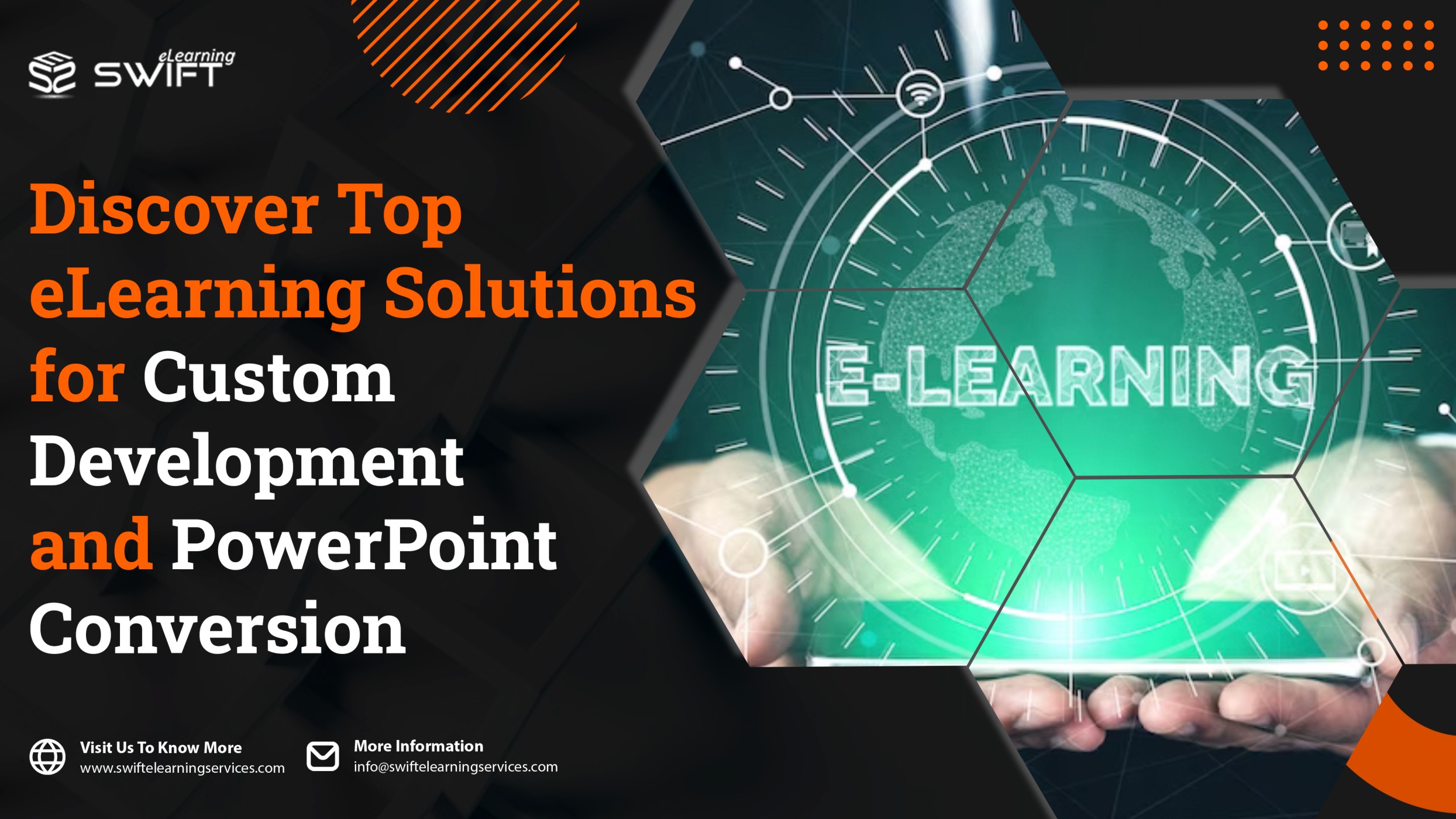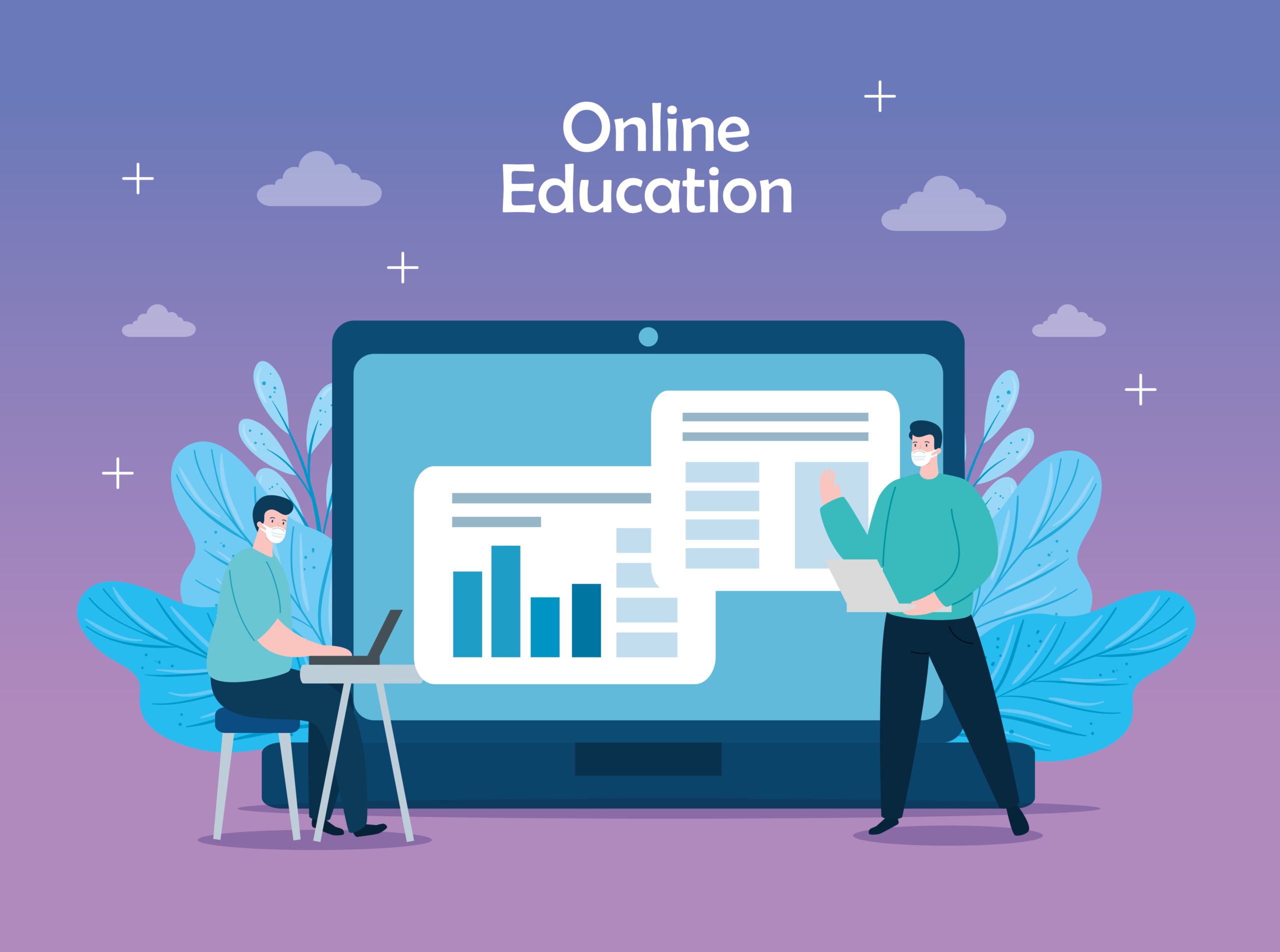Discover Top eLearning Solutions for Custom Development and PowerPoint Conversion
Best eLearning Solutions for Custom Development and PowerPoint Conversion
Whether you’re an educator, a corporate trainer, or someone passionate about online learning, the landscape of eLearning is brimming with possibilities. Custom development and PowerPoint conversion offer a tailored approach to crafting engaging, interactive, and effective online learning experiences that cater specifically to your audience’s needs.
From Learning Management Systems (LMS) that provide a robust infrastructure to authoring tools that empower content creation, we’ll delve into the diverse array of options available. Understanding the advantages, features, and functionalities of these solutions can be a game-changer in creating impactful learning experiences.
In this blog, we’ll explore the top eLearning solutions for custom development and PowerPoint conversion.
Top eLearning Solutions for Custom content Development
When it comes to custom eLearning development, several solutions exist to create tailored educational content:
- Learning Management Systems (LMS): These platforms provide a framework to deliver, manage, and track online courses. They often offer customization options to personalize content, assessments, and user experiences.
- Authoring Tools: These tools enable the creation of interactive eLearning content without extensive programming knowledge. Examples include Articulate Storyline, Adobe Captivate, and Lectora. They allow customization through multimedia, interactions, and assessments.
- Custom Content Development: Some organizations opt for bespoke eLearning content developed by instructional designers, graphic artists, and developers. This method ensures tailor-made content aligned with specific learning objectives and branding requirements.
- Mobile Learning Solutions: With the rise of mobile devices, creating eLearning content optimized for smartphones and tablets is essential. Responsive design or mobile-first development ensures accessibility across various devices.
- Gamification and Simulation: Incorporating game elements or simulations enhances engagement and interactivity in eLearning. Custom development can create immersive experiences tailored to specific learning outcomes.
Choosing the right solution depends on factors like budget, learning objectives, target audience, and technical requirements. Custom development offers flexibility and control over the eLearning experience, ensuring it meets specific organizational needs.
- Learning Management Systems (LMS): Using Learning Management Systems (LMS) for custom development involves tailoring or creating specific functionalities, features, or content within an LMS platform to suit particular needs. This customization can vary widely, from integrating unique assessment tools to designing specialized learning paths or creating custom themes to match branding.
To achieve custom development within an LMS, you might:
- Plugin Development: Building additional functionalities by creating plugins or extensions that integrate with the existing LMS.
- Custom Content Creation: Developing specialized courses, modules, or multimedia content tailored to specific learning objectives.
- User Interface (UI) Customization: Modifying the appearance, layout, and user experience within the LMS to align with branding or user preferences.
- Data Integration: Integrating the LMS with other systems or databases to enable data sharing or automate processes.
- Gamification or Interactive Features: Adding game elements or interactive components to enhance engagement and learning outcomes.
- Personalized Learning Paths: Creating customized learning paths based on individual learner needs, progress, or goals.
Customizing an LMS requires a good understanding of the platform’s architecture and capabilities, as well as proficiency in programming languages, such as JavaScript, PHP, or Python, depending on the LMS being used. Third-party APIs or SDKs may also be utilized to extend functionalities.
The goal of custom development in an LMS is to optimize the learning experience, cater to specific organizational requirements, and improve user engagement and retention.
- Authoring Tools: Authoring tools are often used in custom development to streamline the creation of content or applications. These tools provide an interface or platform where developers or content creators can design, write, and organize various elements without needing to code from scratch.
- They can be particularly useful in scenarios where customization is needed but building everything manually would be time-consuming. These tools might offer templates, drag-and-drop functionalities, or customizable components that allow users to create tailored solutions without extensive coding knowledge.
- There are several excellent authoring tools available for custom eLearning development that cater to various needs and skill levels. Here are some of the top ones:
- Articulate 360: This suite includes Storyline, Rise 360, and other tools. Storyline is powerful for building interactive, custom eLearning modules, while Rise 360 is great for responsive and mobile-friendly courses.
- Adobe Captivate: Known for its versatility, Captivate allows for creating responsive eLearning content, simulations, and software demonstrations. It has robust features for interactivity and customization.
- Lectora: Lectora offers a user-friendly interface with powerful capabilities for creating interactive eLearning courses. It supports HTML5, making courses compatible with various devices.
- Camtasia: While primarily a video editing tool, Camtasia is excellent for creating video-based eLearning content. It allows for screen recording, editing, and adding interactive elements to videos.
- iSpring Suite: This tool integrates well with PowerPoint and allows for easily converting presentations into eLearning courses. It’s known for its simplicity and quick learning curve.
- Elucidat: Elucidat focuses on collaborative course creation and offers templates and themes for quick development. It’s cloud-based and facilitates teamwork among developers.
- Adapt: Adapt is an open-source tool that’s great for creating responsive and mobile-friendly eLearning content. It’s customizable and allows for creating courses that adapt to different devices.
- DominKnow: This platform offers both cloud-based authoring and content management, facilitating collaboration and reuse of content across different projects.
Choosing the right tool often depends on factors like budget, specific requirements, ease of use, and the desired level of interactivity. Some tools may require a learning curve, while others offer a more intuitive interface. It’s a good idea to explore trial versions or demos before making a final decision to ensure the tool aligns with your needs.
- Custom Content Development: Custom content development involves creating unique and tailored content to meet specific needs or objectives. The process typically includes several key steps:
- Understanding Requirements: This involves gathering information about the target audience, objectives, tone, style, and specific content requirements.
- Research: Conducting thorough research to gather relevant information, data, and insights related to the topic or subject matter.
- Planning: Developing a content strategy outlining the structure, format, key messages, and the overall approach to creating the content.
- Creation: Writing or producing the content according to the outlined strategy. This phase involves drafting, editing, and refining the content to ensure accuracy, quality, and alignment with the objectives.
- Review and Approval: Seeking feedback and revisions from stakeholders or clients to refine the content further and ensure it meets their expectations.
- Optimization: Making final adjustments, formatting, and optimizing the content for its intended platform or medium, such as a website, social media, or print.
- Delivery: Publishing or delivering the finalized content to the intended audience through the chosen channels.
- Evaluation: Monitoring the performance of the content, collecting feedback, and analyzing metrics to assess its effectiveness and make improvements for future content development.
Throughout the process, effective communication and collaboration among content creators, subject matter experts, and stakeholders are crucial for successful custom content development. Additionally, staying updated with industry trends and best practices helps in creating engaging and relevant content.
- Mobile Learning Solutions: Mobile learning solutions for custom development refer to creating educational applications or platforms tailored to specific needs or requirements. These solutions are designed to deliver learning content and experiences via mobile devices. Some approaches for developing such solutions include:
- Custom Mobile Apps: Building dedicated mobile applications that cater to specific learning objectives. These apps can offer interactive content, assessments, and features aligned with the desired learning outcomes.
- Responsive Web Platforms: Developing web-based platforms optimized for mobile devices. These platforms can host a variety of learning materials, videos, quizzes, and forums accessible across different screen sizes.
- Adaptive Learning Systems: Creating systems that personalize the learning experience based on individual progress, preferences, and skill levels. These systems often utilize AI and machine learning algorithms to adapt content delivery to each learner.
- Gamified Learning Applications: Incorporating game elements, such as badges, leaderboards, and rewards, to enhance engagement and motivation in the learning process.
- Augmented Reality (AR) and Virtual Reality (VR): Developing applications that leverage AR/VR technologies to provide immersive and interactive learning experiences. These can simulate real-life scenarios or environments for effective learning.
- Microlearning Modules: Designing bite-sized learning modules specifically optimized for mobile consumption. These modules focus on delivering concise and targeted information to facilitate learning on-the-go.
- Social Learning Platforms: Building platforms that encourage collaboration, discussion, and knowledge sharing among learners through social features like discussion forums, chat functionalities, and peer-to-peer interactions.
- Offline Access and Sync: Ensuring that learning materials can be accessed offline and synchronized with the user’s progress once the device reconnects to the internet.
- Accessibility and User Experience (UX): Prioritizing user-friendly interfaces and ensuring accessibility features to accommodate diverse learners, including those with disabilities.
- Analytics and Reporting: Integrating analytics tools to track learner progress, assess engagement levels, and generate reports for instructors or administrators to monitor and improve the learning experience.
The choice of development approach depends on the learning objectives, target audience, technological capabilities, and available resources.
Creating custom mobile learning solutions involves a combination of instructional design, user experience expertise, and technical development to deliver effective and engaging educational experiences.
- Gamification and Simulation: Gamification and simulation are powerful tools used in custom development to enhance learning experiences and engagement.
- Gamification: involves incorporating game-like elements such as points, badges, leaderboards, and rewards into non-game contexts to motivate and engage users. In custom development, it can be applied to training programs, educational courses, or business processes to make them more interactive and enjoyable.
For instance, creating quizzes, challenges, or interactive scenarios that users can navigate through while earning rewards or progressing through levels can enhance learning and retention.
- Simulation: involves creating a model or representation of a real-world system or process. In custom development, simulations are used to mimic real-life situations or environments to facilitate learning, decision-making, or skill development.
For instance, in fields like healthcare or aviation, simulations are used for training purposes to allow learners to practice without real-world risks. In software development, simulations can be used for testing new systems or processes before actual implementation.
Combining gamification with simulation in custom development can create highly engaging and effective learning experiences. For instance, a training program for customer service representatives could involve a simulated customer interaction scenario where the employees earn points or rewards based on their responses and performance. This not only makes the training more enjoyable but also helps in reinforcing learning outcomes.
Ultimately, both gamification and simulation serve as effective tools in custom development by making learning more interactive, engaging, and impactful for users.
Top ELearning Solutions for PPT Conversion
Converting PowerPoint presentations into eLearning modules can be a great way to create engaging and interactive educational content.
Here’s the step-by-step guide on how to convert PowerPoint:
- Content Review: Begin by reviewing your PowerPoint content. Ensure that the information is organized logically and that it aligns with your learning objectives.
- Storyboard Creation: Develop a storyboard that outlines the flow of your eLearning module. Determine the sequence of slides, interactive elements, assessments, and any multimedia components you plan to include.
- Interactive Elements: Enhance your slides by adding interactive elements such as quizzes, drag-and-drop activities, clickable hotspots, simulations, or branching scenarios. This engagement helps reinforce learning.
- Multimedia Integration: Incorporate multimedia elements like videos, audio clips, and animations to make the content more dynamic and engaging. Ensure these elements complement your learning objectives.
- Navigation and Interactivity: Make sure the navigation within the eLearning module is intuitive. Include buttons or menus for easy movement between sections or topics.
- Responsive Design: Consider creating a responsive design that adapts to different devices (desktops, tablets, smart phones) for a seamless learning experience.
- Accessibility: Ensure your eLearning content is accessible to all learners. Use alt text for images, provide closed captions for videos, and ensure readability for visually impaired users.
- Testing and Feedback: Test your eLearning module thoroughly to check for functionality, interactivity, and overall user experience. Gather feedback from potential users to make improvements.
- Publishing: Choose the appropriate eLearning authoring tool (such as Articulate Storyline, Adobe Captivate, or iSpring) to convert your PowerPoint into a compatible format (SCORM, xAPI) for deployment on learning management systems (LMS) or online platforms.
- Continuous Improvement: After deployment, collect data and analytics to assess the effectiveness of your eLearning module. Use this information for future improvements.
Note that the key to successful eLearning conversion is to keep the content engaging, interactive, and aligned with the learning objectives.
Conclusion
As discussed, when choosing the right eLearning solution, consider factors such as your specific requirements, budget, ease of use, scalability, and the level of customization needed for your eLearning courses.
From LMS to Virtual Reality, we have looked at various eLearning solutions that support custom eLearning development and checked the process of PowerPoint conversion.
Frequently Asked Questions (FAQs)
1. What is custom eLearning development?
Custom eLearning development involves creating tailored online learning experiences specifically designed to meet the unique needs and objectives of a particular audience or organization. It includes designing courses, modules, or entire learning platforms from scratch rather than using pre-built, off-the-shelf solutions.
2. What are the advantages of your custom eLearning development?
Our Custom eLearning solutions offer several benefits, including:
- Tailored Content: Courses can be customized to address specific learning objectives, ensuring relevance to learners’ needs.
- Branding and Identity: Organizations can incorporate their branding elements, creating a consistent look and feel.
- Flexibility: Custom solutions can adapt to evolving learning needs and changing content requirements.
- Engagement: Designing content with the audience in mind can enhance engagement and learning outcomes.
3. What is the process of your custom eLearning development process?
Our process typically involves:
- Analysis: Understanding the learning goals, audience, and content requirements.
- Design: Creating a blueprint for the course structure, content, and interactivity.
- Development: Building the eLearning content, incorporating multimedia elements, and ensuring functionality.
- Testing: Thoroughly evaluating the content for functionality, usability, and effectiveness.
- Deployment: Making the custom eLearning solution available to the intended audience.
4. What types of content can you develop through custom eLearning?
Custom eLearning can encompass various content formats, including:
- Interactive Modules: Interactive presentations, simulations, or scenarios.
- Video-based Learning: Custom-produced videos or animations for instructional purposes.
- Gamified Learning: Incorporating game elements to enhance engagement and learning.
- Assessments and Quizzes: Tailored assessments to gauge learners’ understanding.
5. How long does it take to develop custom eLearning content?
The timeline varies based on complexity, scope, and content requirements. Simple modules might take a few weeks, while comprehensive programs could take several months. Factors such as multimedia integration, interactivity level, and review cycles impact development time.






